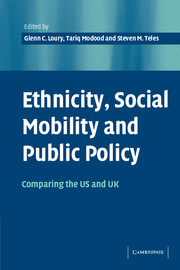Part II - Informal social networks
Published online by Cambridge University Press: 22 September 2009
Summary
Towards a synthetic introduction re households, families, and neighborhoods
The social mobility that we track in formal institutions of politics, the workplace, and education is powerfully influenced by the less formal social structures of the family, neighborhood, and ethnic group. It is in these less formal structures that the tastes, habits, disciplines, and capacities of individuals are formed. What is more, these informal structures penetrate into formal institutions, providing leverage for some and disadvantages for others. It is impossible to explore the relationships between race, ethnicity, and social mobility without examining the sites in which the capacities that allow individuals to move up are produced, or are hindered. The chapters in this section explore the way that social mobility and ethno-racial stratification are produced by the interaction of these formal and informal structures.
The process of social mobility for ethnic and racial minorities is almost without exception a geographic process. Ethnicity and race feed into the process by which individuals sort themselves (and others sort them) out in space. On the one hand, most ethnic and racial groups have strong reasons to prefer geographic clustering, since such a pattern puts them in easy association with those who speak the same language, profess the same religion, and who can provide networks into the labor market, while also providing a degree of concentration necessary for the provision of group-specific services.
- Type
- Chapter
- Information
- Ethnicity, Social Mobility, and Public PolicyComparing the USA and UK, pp. 123 - 130Publisher: Cambridge University PressPrint publication year: 2005



